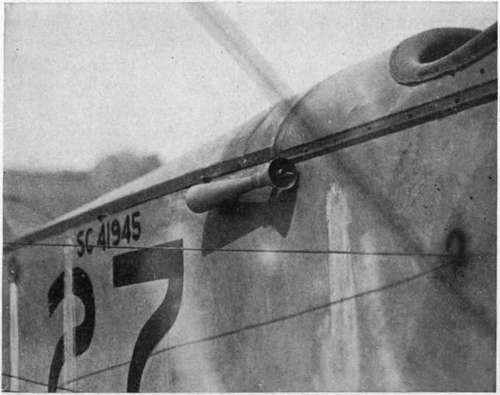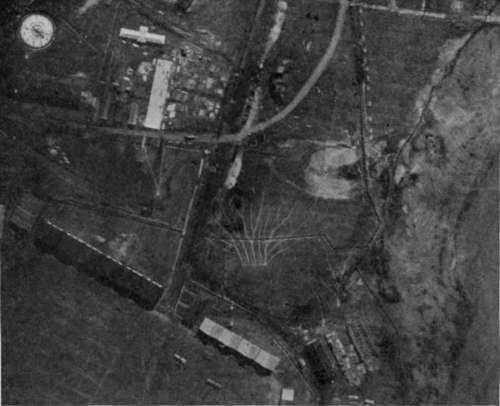Methods Of Holding Film Flat
Description
This section is from the book "Airplane Photography", by Herbert E. Ives. Also available from Amazon: Airplane photography.
Methods Of Holding Film Flat
Several means have been proposed and used for holding the film flat. Disregarding mere pressure guides at the side, which are suitable only for small area films (up to 4X5 inch), the successful means have taken three forms: pressure of a glass plate, pressure of the shutter curtain, and suction. A glass pressure plate can be used in either of two ways; the film may be in continuous contact with it or may be pressed against its surface only at the moment of exposure. The advantage of this first method lies solely in its mechanical simplicity; its disadvantage in the likelihood of scratches or pressure markings on the film. Where a glass plate is used there is always the chance of a dust or dirt film accumulating, or of the condensation of moisture, to impair the quality of the negative. There is, moreover, an inevitable loss of light (about 10%), together with some slight distortion, due to the bending of the marginal oblique rays through the thickness of the glass. In cases where a filter would normally be employed, the loss of light is minimized by using yellow glass for the plate, so that it serves for filter and film holder as well.
Pressure of the shutter curtain is utilized in the Duch-atellier film camera by furnishing the edges of the curtain aperture with heavy velvet strips, whose light and gentle pressure during the passage of the shutter holds the film against a metal back. In many ways this is the simplest film-holding device; it occasions no loss of light, and needs no mechanical movements or external accessories, such as are called for in the suction devices next described. There is always danger of markings on the film, if the velvet is not of the right thickness and softness, and the operation and speed control of the shutter are necessarily complicated by the additional frictional load.
Suction of the film against a perforated back plate has been found a very successful means of securing flatness. Suction at the moment of exposure may be produced by the action of a bellows, which has been compressed beforehand by the camera-driving mechanism. Continuous suction can be produced either by a continuously driven pump, or by a Venturi tube placed outside the fuselage. The Venturi tube (Fig. 55) consists of a pipe built up of two cones, placed vertex to vertex, to form a constriction. When air is forced through this at high velocity suction is produced in a small diameter tube taken off at the constriction. A suction of two centimeters of mercury, acting through holes about one centimeter equidistant from each other in the back plate, has been found adequate to hold flat a film 18X24 centimeters.
One merit of suction applied only at the moment of exposure is that the film-driving mechanism does not have to work against the drag of the suction. Continuous suction, on the other hand, gives a longer opportunity for flattening out kinks in the celluloid, and easily permits movement of the film during the exposure, either for the purpose of permitting a longer exposure or for the purpose of preventing distortion due to the focal-plane shutter. A disadvantage of continuous suction is the production of minute scratches on the celluloid surface as it drags over the suction plate. These are ordinarily too small to cause trouble, but may show up when printing is done in an enlarging camera charges are noticeably less frequent with film coated on the back with gelatine ("N.C."), but the extra gelatine surface is extremely undesirable. When handled by developing machines, as large rolls must be, this back gelatine surface becomes scratched and bruised in a serious manner. Plain unbacked film is much to be preferred if the static can be obviated.

Fig. 55. - Venturi tube on side of plane.
To avoid static, it is necessary to provide for the immediate dissipation of all acquired electrical charges. Experi:
Static discharges are produced by the friction of the celluloid against the pressure back or other surfaces with which it comes into contact. They show in the developed film as branching tree-like streaks (Fig. 56) and in cold dry weather may be numerous enough to ruin a picture. The dismerits made by the United States Air Service have shown that nothing is so good as rather rough cloth, thoroughly impregnated with graphite, held in close contact with the celluloid during as great a portion of its travel as possible. In the United States Air Service film camera which uses suction through a perforated back plate, the plate has been covered with thin graphited cloth, and similar cloth sheets are pressed against the film rolls by sheets of spring metal (Fig. 65). In cameras with this equipment no trouble has been experienced with static.

Fig. 56. - Print from film camera negative, showing static discharge, and (upper left-hand corner) record of altitude and compass direction made by Williamson film camera auxiliary lens (Fig. 58).
Continue to:
- prev: Chapter XI. Aerial Film Cameras
- Table of Contents
- next: Representative Film Cameras. The English F Type (Williamson)
Tags
camera, lens, airplane, aerial, film, exposure, photography, maps, birdseye
